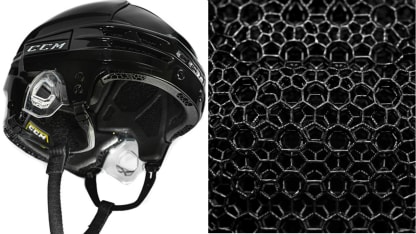The helmets, which are lined with a polyurethane-based lattice instead of standard foam, were worn by Toronto Maple Leafs forwards Auston Matthews and John Tavares, and Columbus Blue Jackets defenseman Seth Jones this season, but will be available to all players next season.
Offering a custom fit for each player and breathability that isn't found in typical foam protection, the Super Tacks X helmet is unlike others that players have previously worn.
The partnership came about because of Carbon's ability to 3D print various items 25 times faster than the norm through their patented process. Carbon already had partnerships with adidas to use a similar lattice on its 4D shoes featuring the world's first 3D printed midsole, and football helmet manufacturer Riddell. It took about six months for CCM and Carbon to come up with the hockey helmet.
"CCM does have a fairly robust scientific approach so we have a lot of data that helped facilitate the solution," said Jeffrey Dalzell, vice president of product creation at CCM Hockey. "I say the best way to get a great engineered solution is by telling the engineers what you're looking for exactly and CCM has that capability.
"We can literally tell them can you solve this problem and here are the parameters in which we need to do it and that's where the relationship became very positive because Carbon did say this is great information now how do we actually get to a solution?"
The benefits of the lattice liner boil down to unprecedented breathability, comfort and protection, but these helmets are only possible now because of a perfect storm of available data and technology.
CCM provided Carbon with years of impact data the company has collected on the various types of collisions hockey players endure during a game. These collisions are classified as either linear or rotational impacts, where linear refers to direct strikes (like a puck) and rotational causes the head to move out of sync with the rest of the body.
Previously, layers of foam were used to protect against these collisions, but Carbon's lattice allows for thousands of precisely positioned struts (the bars that comprise the lattice) to be engineered to counter these impacts and be placed in the space between each player's head and the shell of the helmet. A tighter lattice with smaller cells is better suited to handle smaller impacts, whereas larger cells are better for larger impacts.
"Each one is designed using millions of data points that CCM has collected over a long period of time to provide the best performance possible," said Phil DeSimone, chief customer officer and co-founder of Carbon. "So each strut is specifically designed to expense energy both in linear and rotational ways better than what foam can do."
The process of getting each player measured for his helmet is a simple one that uses scanning technology that is already available on Apple iPads, which all NHL teams have, and can be performed by team equipment managers or CCM representatives.
Once the scan is taken, it is delivered to Carbon through an app, and the helmet is ready to use within six weeks.

